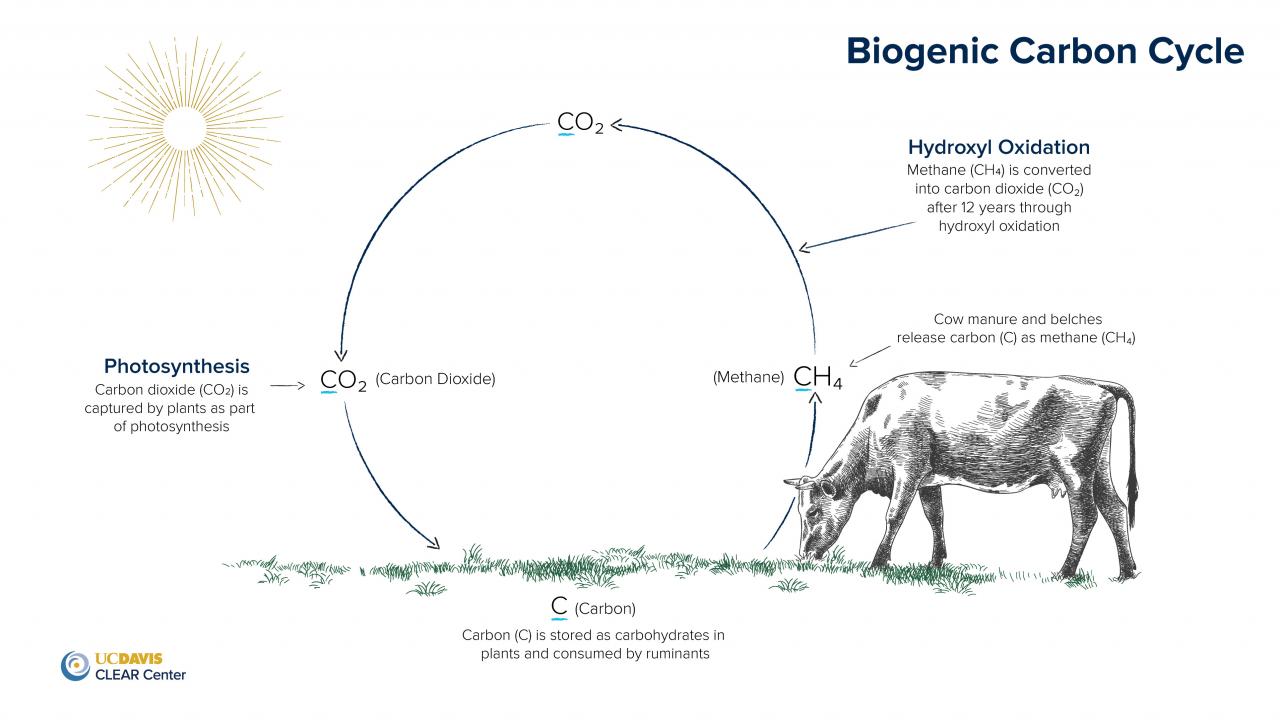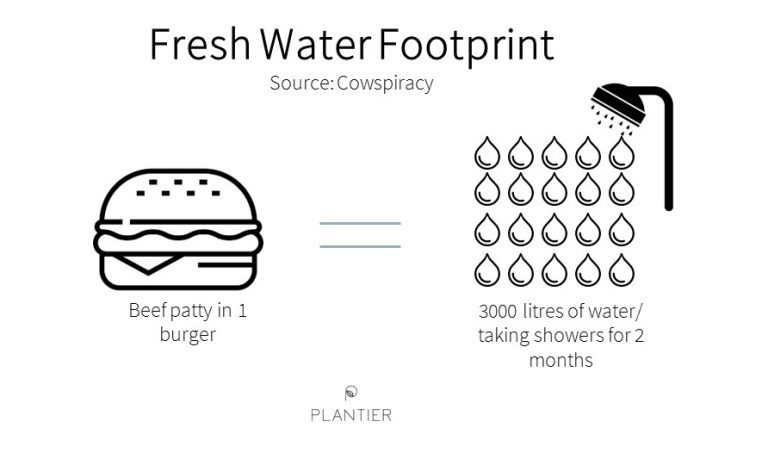Debunking Vegan Environmental Claims: A Comprehensive Analysis of Animal Agriculture and Climate Change
In recent years, the environmental impact of our food choices has become a hot topic, with vegan advocates often claiming that animal agriculture is a major driver of climate change. These arguments have led many to believe that adopting a plant-based diet is crucial for saving the planet. But is it really that simple? This post aims to dig deeper into the scientific evidence, debunking vegan environmental claims and exploring the nuanced reality of livestock farming’s environmental impact.
The Claims
Vegan environmental advocates typically argue that livestock farming significantly contributes to climate change through:
- Methane emissions from cattle [1]
- Nitrous oxide emissions from manure and fertilizers
- Carbon dioxide emissions from land use changes and farm operations
They often suggest that a global shift to plant-based diets would dramatically reduce greenhouse gas emissions and mitigate climate change. However, as we’ll see, the reality is more complex. [1, 2, 3, 4]
Thesis Statement
While animal agriculture does contribute to greenhouse gas emissions, its impact on climate change has been significantly overstated. This post will examine the roles of methane, nitrous oxide, and carbon dioxide in animal agriculture, exploring how recent research and technological advancements are changing our understanding of livestock’s environmental footprint. By critically analyzing these factors, we aim to provide a more balanced perspective on this complex issue, and show how livestocks farmings contribution has been exaggerated, particularly in comparison to other sectors. [5]
Methane: A Misunderstood Greenhouse Gas
When it comes to discussions about livestock and climate change, methane (CH4) often takes center stage. [6] But the story of methane is more complex than many realize, and understanding this complexity is crucial in debunking vegan environmental claims. To truly understand the impact of methane from animal agriculture, we need to delve deeper into its production, lifecycle, and how it’s measured.
The Methane Cycle: Not All Greenhouse Gases Are Created Equal
Unlike carbon dioxide (CO2), which can remain in the atmosphere for centuries, methane has a relatively short atmospheric lifetime of about 12 years. [7] This characteristic of methane is often overlooked in climate discussions, leading to potential misunderstandings about its long-term impact.
- Methane Oxidation: After about a decade, methane in the atmosphere oxidizes, turning into CO2 and water vapor. This CO2 then becomes part of the natural carbon cycle.
- Carbon Neutral Cycle: In the case of biogenic methane from livestock, this creates a near carbon-neutral cycle. The CO2 produced from methane oxidation is then absorbed by plants, which may be consumed by animals, continuing the cycle.
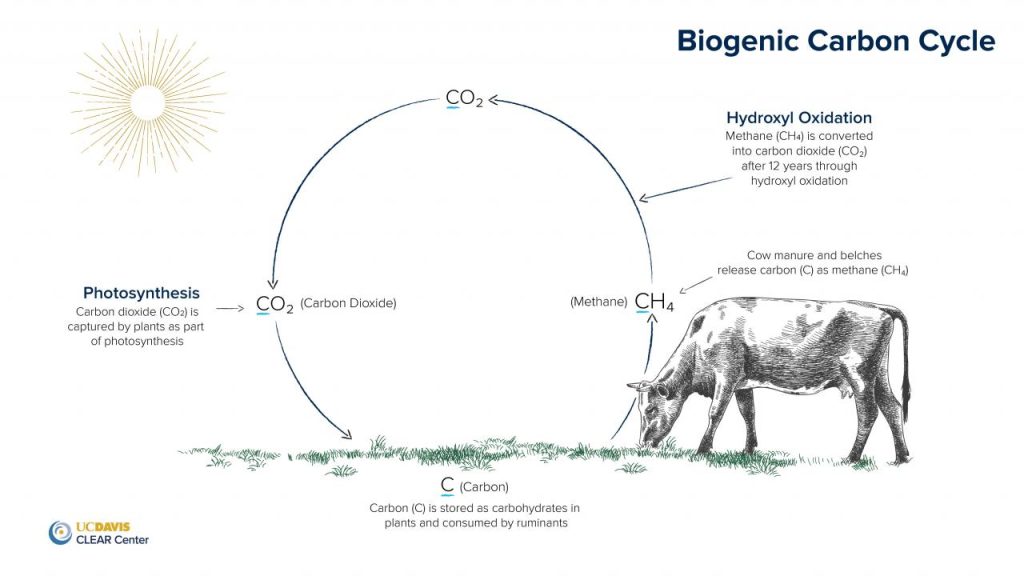
Biogenic vs. Fossil Methane: A Critical Distinction
It’s crucial to distinguish between biogenic methane (from biological sources like cattle) and fossil methane (from oil and gas extraction). This distinction is often missed in discussions about methane emissions.
- Biogenic Methane: Produced by livestock through enteric fermentation and manure management. This methane is part of a natural carbon cycle, where the carbon emitted was recently captured from the atmosphere by plants.
- Fossil Methane: Released during the extraction and processing of fossil fuels. This methane introduces new carbon into the atmosphere that has been locked away for millions of years.
- Net Impact: While both types of methane have the same warming effect in the short term, biogenic methane does not increase atmospheric carbon in the long term if the number of livestock remains constant.
Reassessing Methane’s Impact: GWP vs. GWP*
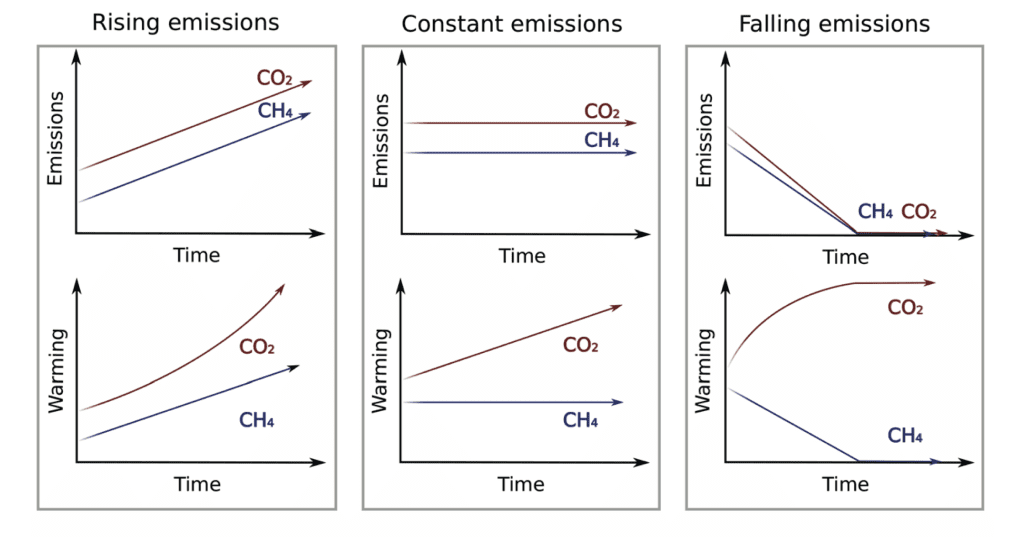
The way we measure methane’s warming potential can significantly affect how we perceive its impact on climate change. Traditionally, the Global Warming Potential (GWP) metric has been used, but this does not accurately represent methane’s impact over time. A newer metric, GWP*, has been proposed to address some of the limitations of the conventional GWP.
Scientific Explanation:
Global Warming Potential (GWP):
GWP is a measure of how much energy the emissions of 1 ton of a gas will absorb over a given period, relative to the emissions of 1 ton of carbon dioxide (CO2). The standard time period used is 100 years, denoted as GWP100.
For methane, the GWP100 is approximately 28-34, meaning that over a 100-year period, 1 ton of methane will have 28-34 times the warming effect of 1 ton of CO2. This value accounts for methane’s higher radiative efficiency (ability to absorb energy) and its atmospheric lifetime. [8]
However, GWP has limitations when applied to short-lived climate pollutants (SLCPs) like methane:
- It doesn’t account for the timing of emissions over the 100-year period.
- It overestimates the long-term impact of constant methane emissions.
- It doesn’t reflect the cooling effect that occurs when methane emissions are reduced.
Global Warming Potential Star (GWP): GWP is an alternative metric proposed by researchers at Oxford University. It aims to better represent the warming impact of SLCPs like methane over time.
The key difference is that GWP* equates a sustained emission of an SLCP to a one-time release (pulse emission) of CO2. Mathematically, GWP* is expressed as:
GWP* = 4 × GWP100 × ΔE + S × E
Where:
- ΔE is the change in SLCP emission rate
- E is the current emission rate
- S is a factor representing the short-term impact of SLCP emissions
This formula captures three crucial aspects:
- The short-term warming effect of new methane emissions (4 × GWP100 × ΔE)
- The long-term impact of sustained emissions (S × E)
- The cooling effect when methane emissions are reduced (negative ΔE)
Implications:
Using GWP* instead of GWP100 can dramatically change our understanding of methane’s impact:
- For constant methane emissions (ΔE = 0), the warming effect is much lower than what GWP100 suggests.
- Increasing methane emissions have a larger short-term impact.
- Decreasing methane emissions results in a cooling effect, which GWP100 doesn’t capture.
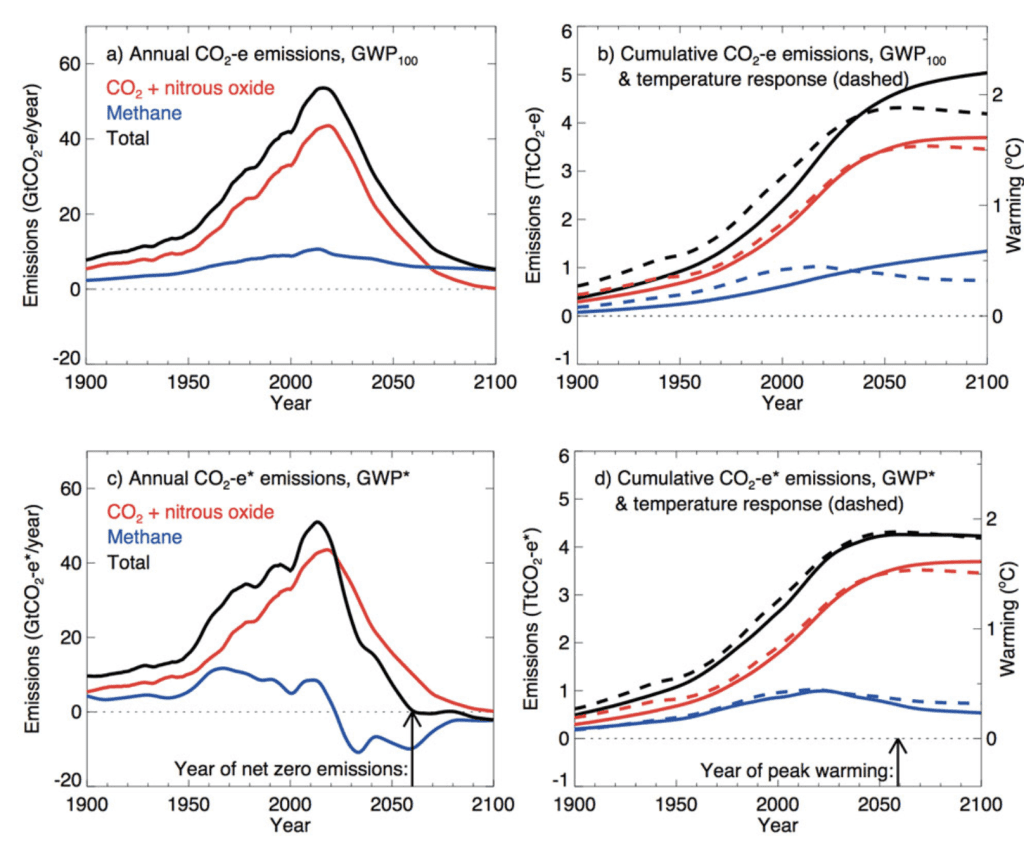
Simplified Explanation for General Readers:
Imagine you’re filling a bathtub with water. The traditional way of measuring methane’s impact (GWP) is like saying that methane turns the tap on much stronger than CO2, but it doesn’t account for the fact that there’s also a drain in the bathtub.
Methane is like hot water that flows in quickly but also drains quickly. CO2 is like lukewarm water that flows in slowly but barely drains at all.
The old method (GWP) only looks at how much water is flowing in over a long period, without considering the draining. This makes it seem like methane is always filling the tub much faster than CO2.
The new method (GWP*) is like considering both the inflow and the outflow. It recognizes that:
- When you first turn on the hot water (methane), the tub warms up quickly.
- If you keep the tap at the same level, the tub’s temperature stabilizes because the hot water flowing in matches the hot water draining out.
- If you reduce the flow of hot water, the tub actually starts to cool down a bit.
This new way of measuring helps us understand that:
- Constant methane emissions (like from a stable number of cows) don’t keep making things hotter year after year.
- Increasing methane emissions do cause quick warming.
- Decreasing methane emissions can actually help cool things down in the short term.
By using this new measurement (GWP*), we get a more accurate picture of how methane from sources like livestock affects global warming over time. It shows that while methane is still a powerful greenhouse gas, its long-term impact is not as severe as previously thought if emissions remain stable, and can have a cooling effect if it decreases.
Technological Advancements in Methane Reduction
Despite the reassessment of methane’s impact, efforts to reduce emissions from livestock are still valuable. Several promising technologies and practices are being developed:
Feed Additives:
- 3-Nitrooxypropanol (3-NOP): This additive has shown promising results in reducing enteric methane emissions by up to 30% without affecting animal health or productivity. [9]
- Seaweed Supplements: Certain species of seaweed, particularly Asparagopsis taxiformis, have demonstrated the ability to reduce methane emissions by over 80% in some trials. [10]
- Essential Oils: Some plant-based essential oils have shown potential in reducing methane production in ruminants. [11]
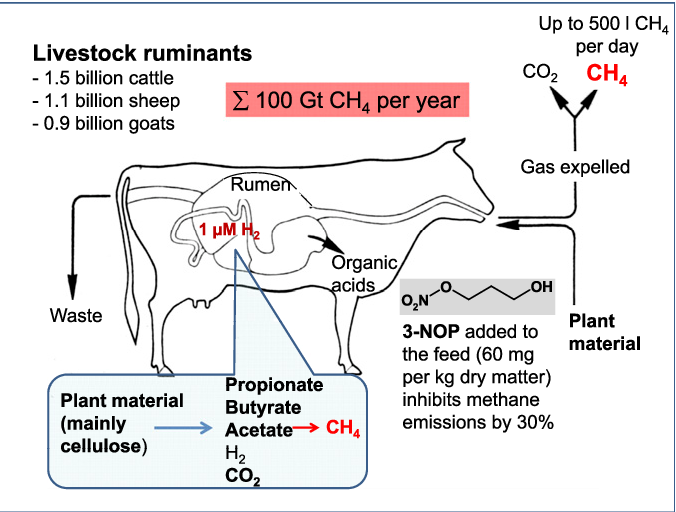
Genetic Selection:
- Researchers are identifying genetic markers associated with lower methane production in cattle. Through selective breeding, it’s possible to develop cattle lines that naturally produce less methane. [12]
Improved Manure Management:
- Anaerobic Digesters: These systems capture methane from manure and convert it into biogas, which can be used for energy production. [13]
- Covered Lagoons: Covering manure storage areas prevents methane from escaping into the atmosphere and allows for its capture and utilization. [13]
Precision Livestock Farming:
- Advanced monitoring systems can help optimize feed efficiency and animal health, indirectly reducing methane emissions per unit of production. [14]
Summary:
Understanding the nuances of methane production, its lifecycle, and its measurement is crucial for accurately assessing the environmental impact of livestock. While methane from animal agriculture does contribute to global warming, its impact is less severe than often portrayed, especially when considering the difference between biogenic and fossil methane, and when using more appropriate metrics like GWP*.
Nitrous Oxide: The Lesser-Known Greenhouse Gas

Nitrous oxide (N2O) is another greenhouse gas associated with agriculture, including both crop and animal production.
Understanding Nitrous Oxide
Nitrous oxide is a greenhouse gas with a global warming potential (GWP) 265-298 times that of CO2 over a 100-year period. [15] It has an atmospheric lifetime of approximately 114 years, making it a long-lived climate pollutant. [16] N2O is part of the nitrogen cycle and is produced naturally in soils through microbial processes of nitrification and denitrification.
Sources of Nitrous Oxide in Agriculture
- Synthetic Fertilizers: The application of nitrogen-based fertilizers is a major source of N2O emissions. When more nitrogen is applied than plants can immediately use, the excess can be converted to N2O. [16]
- Manure Management: Animal waste contains significant amounts of nitrogen. As this manure decomposes, it can release N2O, especially under certain storage conditions. [16]
- Soil Management Practices: Tillage, irrigation, and other soil management practices can influence N2O emissions by affecting soil structure, moisture content, and microbial activity. [16]
- Crop Residues: The decomposition of crop residues left on fields can lead to N2O emissions, particularly if the residues have a high nitrogen content. [16]
- Nitrogen-Fixing Crops: Legumes and other nitrogen-fixing plants can indirectly contribute to N2O emissions by increasing soil nitrogen levels. [16]
Mitigation Strategies for Nitrous Oxide Emissions
Precision Agriculture:
- Advanced soil testing: Regular and detailed soil analysis can help farmers understand the exact nutrient needs of their crops. [19]
- GPS-guided application systems: These allow for more precise fertilizer application, reducing excess nitrogen that can lead to N2O emissions. [20]
- Variable rate technology (VRT): This allows for adjusting fertilizer application rates based on specific field conditions and crop needs. [21]
Improved Fertilizer Management:
- Split applications: Applying fertilizer in smaller, more frequent doses can better match plant uptake and reduce excess nitrogen in the soil. [18]
- Slow-release fertilizers: These products release nitrogen gradually, better aligning with plant needs and reducing the risk of N2O formation. [18]
- Nitrification inhibitors: Chemical compounds that slow the conversion of ammonium to nitrate, potentially reducing N2O emissions. [18]
- Urease inhibitors: These can be used with urea-based fertilizers to slow the hydrolysis of urea, reducing ammonia volatilization and potentially N2O emissions. [18]
Enhanced Efficiency Fertilizers (EEFs):
- Controlled-release fertilizers: These use coatings or chemical forms that slow nutrient release. [18]
- Stabilized nitrogen fertilizers: These include compounds that inhibit urease activity or nitrification. [18]
Improved Manure Management:
- Composting: Proper composting can reduce N2O emissions compared to traditional storage methods. [17]
- Anaerobic digestion: This process can capture methane for energy production and potentially reduce N2O emissions. [17, 18]
- Timing of manure application: Applying manure when crops can most efficiently use the nutrients can minimize excess nitrogen in the soil. [21]
Soil Management Practices:
- Reduced tillage or no-till farming: These practices can improve soil structure and reduce N2O emissions. [18]
- Cover crops: Planting cover crops can help absorb excess nitrogen from the soil, reducing the potential for N2O formation. [18]
- Crop rotation: Diversifying crop rotations, especially including legumes, can improve nitrogen use efficiency. [18]
Drainage Management:
- Controlled drainage systems: These can help manage soil water content, potentially reducing conditions favorable for N2O production. [21]
Biochar Application:
- Adding biochar to soils has shown potential in some studies to reduce N2O emissions, though more research is needed. [18]
Measuring and Monitoring N2O Emissions
Accurately measuring N2O emissions from agricultural sources is challenging due to their spatial and temporal variability. Several methods are used: [22]
- Chamber measurements: Small chambers placed on the soil surface to collect gas samples.
- Micrometeorological techniques: These measure N2O fluxes over larger areas.
- Modeling approaches: Various models are used to estimate N2O emissions based on environmental factors and management practices.
Policy and Economic Considerations
Reducing N2O emissions often aligns with improved nitrogen use efficiency, which can provide economic benefits to farmers through reduced fertilizer costs. However, implementing some mitigation strategies may require initial investments or changes in farming practices.
Policy approaches to encourage N2O emission reductions might include:
- Incentives for adopting precision agriculture technologies
- Support for research and development of enhanced efficiency fertilizers
- Education and extension programs on best management practices
- Potential inclusion of N2O in carbon credit or cap-and-trade systems
Summary:
Nitrous oxide is a potent and long-lived greenhouse gas that poses challenges in agricultural systems. However, through a combination of improved management practices, technological innovations, and policy support, there are numerous opportunities to reduce N2O emissions from agriculture. Many of these strategies not only benefit the climate but can also improve farm efficiency and productivity.
It is important to focus on technological development to reduce greenhouse gas emissions, and not simply let whoever screams the loudest dictate the way forward.
Carbon Dioxide: The Complete Picture in Agriculture
The relationship between carbon dioxide and plant growth is both fundamental and nuanced. CO2 is as essential to plants as oxygen is to animals. In many environments, the amount of available carbon dioxide is actually a limiting factor for plant growth. This means that, to a point, increasing CO2 levels will boost plant productivity. [23]
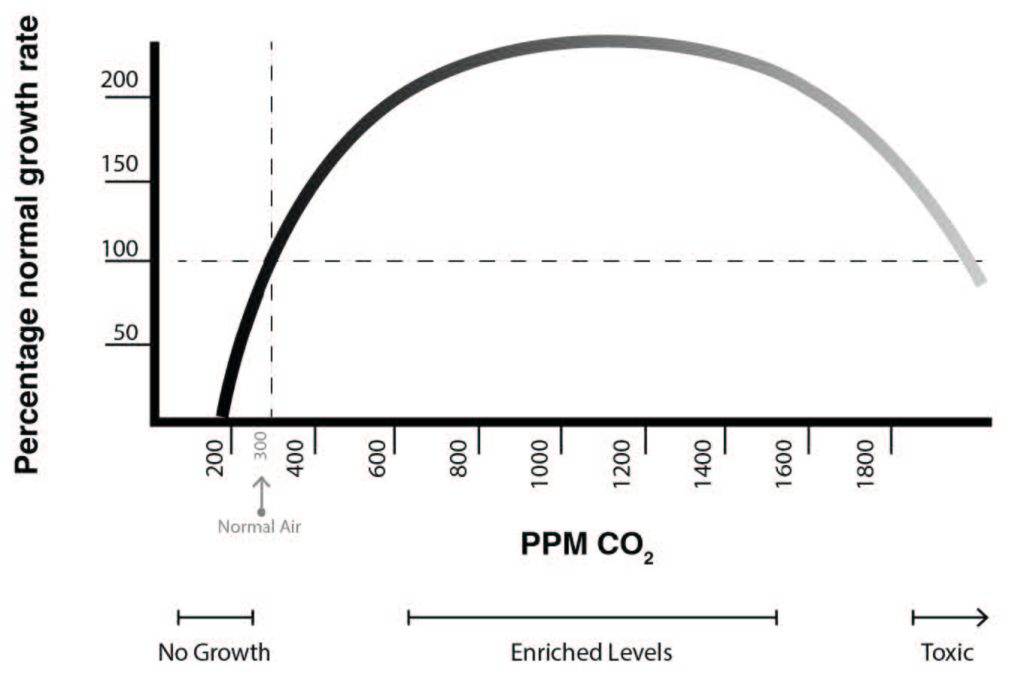
There is a slight difference in the type of plants however. Plants we classify as “C3” – which include important crops like wheat, rice, and soybeans – tend to benefit more from increased CO2. These plants evolved in a world with lower carbon dioxide levels, and they’re not as efficient at capturing it. Give them more CO2, and they thrive. Meanwhile, “C4” plants like corn and sugarcane already capture carbon dioxide to a higher degree, and therefore show a less dramatic response, yet even they show a noticeable increase. [23]
95% of the plants in the world are “C3” plants, and 5% is “C4” plants. [26] This means we will see a very large increase in crop yields with an increase of CO2. [24]
There’s another interesting effect of increased CO2 on plants: it often leads to improved water use efficiency. Plants take in carbon dioxide through tiny pores in their leaves called stomata. When there’s more CO2 in the air, plants can afford to keep these pores open for shorter periods, losing less water in the process. In a world where water scarcity is an increasing concern for agriculture, this could be a significant benefit. [25]
Effects of Increased CO2 on Crop Yields
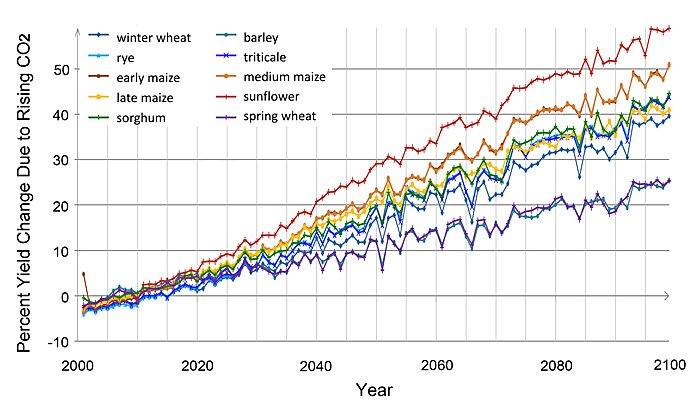
Many crops do show increased yields under elevated CO2 conditions, especially in controlled experiments. Wheat, rice, and soybeans often produce more biomass and grain when grown in CO2-enriched environments. This “CO2 fertilization effect” could be a way to feed the growing population.
Agricultural Practices and Soil Carbon Storage: A Potential Solution
While much of the discussion around CO2 and agriculture focuses on its role as a greenhouse gas, there’s another side to the story. Agricultural lands, when managed properly, have the potential to act as significant carbon sinks, pulling CO2 from the atmosphere and storing it in the soil. [27]
One practice gaining attention is no-till farming. Traditional plowing turns over the top layer of soil, exposing organic matter to the air and accelerating its decomposition – and the release of stored carbon. No-till methods minimize this disturbance, allowing more carbon to remain locked in the soil. Over time, this can lead to increased soil organic matter, which not only sequesters carbon but also improves soil health and water retention. [28]
Cover cropping is another powerful tool. By planting crops during otherwise fallow periods, farmers can increase the amount of biomass – and therefore carbon – added to the soil. These crops also help prevent erosion, improve soil structure, and can even help with pest control. [29]
Rotational grazing, when done properly, can also contribute to carbon sequestration. By carefully managing how and when animals graze, farmers can promote more vigorous grass growth. This, in turn, can lead to deeper, more extensive root systems that add more carbon to the soil. It’s worth noting, though, that the effectiveness of this method varies greatly depending on the specific ecosystem and management practices. [30]
Agroforestry – the integration of trees into agricultural landscapes – offers perhaps the most dramatic potential for carbon sequestration. Trees can store large amounts of carbon in their wood and roots, and their presence can also improve soil carbon levels. Beyond carbon storage, agroforestry can provide additional benefits like improved biodiversity, erosion control, and even additional income streams for farmers. [31]
Challenges in Measuring Agriculture’s CO2 Impact
Quantifying the impact of agriculture on atmospheric CO2 is a complex task, akin to measuring a river’s volume while standing in its rushing current. The challenges are numerous and varied, changing from one moment to the next, from one field to another.
Consider the vast diversity of agricultural landscapes across the globe. From Southeast Asian rice paddies to American Midwest wheat fields, from small African subsistence farms to high-tech Dutch greenhouses – each environment interacts with carbon dioxide uniquely. Soil types vary dramatically, even within a single farm. A sandy loam might release carbon quickly, while a heavy clay holds onto it tenaciously. The microclimates created by hills, trees, and bodies of water add further complexity.
Time, too, plays tricks on our measurements. Carbon fluxes in agricultural systems change not just seasonally, but daily and even hourly. A warm, sunny day might see plants eagerly absorbing CO2, while a cool, cloudy one slows this process. Seasonal changes in temperature and rainfall can cause dramatic swings in carbon uptake and release. Long-term trends might take decades to become apparent, outlasting most research projects.
Our measurement tools each have strengths and limitations. Traditional soil sampling provides detailed data but is labor-intensive and can miss fine-scale variations. Advanced techniques like eddy covariance towers offer continuous measurements of carbon exchange but are expensive and complex to operate. Satellite remote sensing promises broad-scale monitoring, but accurately assessing soil carbon from space remains challenging.
Adding another layer of complexity is land use history. A field that was once forest, then pasture, and is now cropland carries the legacy of these past uses in its soil carbon content. Distinguishing the impact of current practices from this historical context is daunting.
Despite these challenges, scientists continue refining our understanding of agriculture’s CO2 impact. New technologies, comprehensive datasets, and sophisticated modeling techniques are gradually filling knowledge gaps. However, the system’s complexity ensures that some uncertainty will always remain. This uncertainty underscores the importance of critical thinking when evaluating environmental claims.
The Limitations of Simplistic Carbon Accounting
In our quest to understand and mitigate agriculture’s environmental impact, we often seek simple, quantifiable metrics. This often takes the form of carbon accounting – attempting to sum up the carbon emissions or sequestration of a crop, farm, or agricultural product in a single number. While useful, this approach has significant limitations we must recognize to avoid oversimplifying a complex issue. Developing critical thinking skills is crucial for navigating these complexities.
One primary shortcoming is the failure to capture the full nutritional and societal value of different foods. For example, comparing the carbon footprint of meat to grains might lead to favoring grain production. However, this ignores the crucial micronutrients that meat provide – nutrients essential for human health that require supplements (with their own carbon footprints) to replace.
Similarly, focusing solely on carbon numbers fails to account for the myriad ecosystem services that agricultural lands provide. A well-managed pasture might have a higher carbon footprint than a monoculture crop field, but that pasture might also support biodiversity, improve water retention, prevent soil erosion, and provide aesthetic and cultural value not captured in a simple carbon metric.
The socio-economic aspects of agriculture are another blind spot. Agricultural practices are deeply entwined with cultural traditions, local economies, and food security concerns. A high-emission food product might be crucial to a region’s culinary heritage or a community’s primary income source. Making decisions based solely on carbon numbers without considering these factors could lead to unintended negative consequences.
Another limitation lies in the static nature of most carbon accounting methods. Agriculture is dynamic, with new technologies and practices constantly emerging. A carbon footprint calculated today might be outdated in a few years as farming methods evolve, potentially leading to policy decisions or consumer choices based on outdated information.
Subsistence Farming and the Misrepresentation of Animal Agriculture’s Impact
It’s crucial to address the often-overlooked issue of subsistence farming and how global averages is often used to misrepresent animal agriculture’s true impact.
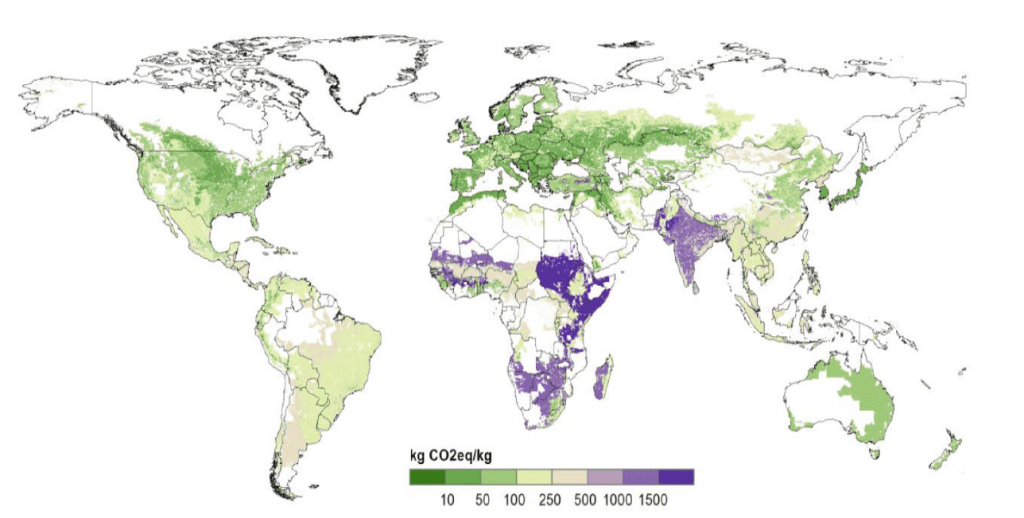
Subsistence farming, a practice where farmers grow food primarily to feed themselves and their families, is common in many developing countries. These small-scale operations often rely on traditional methods and have limited access to modern, efficient farming technologies. As a result, their greenhouse gas emissions per unit of production, on average, is much higher than those of large-scale, technologically advanced farms typical in developed nations. [32]
However, vegan advocates use global averages when discussing animal agriculture’s environmental impact. [33] This approach is disingenuous, as it greatly increases the greenhouse gas emissions that are then attributed to the more efficient, sustainable Western animal agriculture. These are the reasons for the much higher environmental impact in the developed world:
- Technological Disparities: Developed nations often employ advanced technologies and management practices that significantly reduce emissions. For example, precision feeding, genetic improvements, and better manure management in the U.S. and Europe have led to substantial reductions in greenhouse gas emissions per unit of animal product. [32]
- Efficiency Variations: Large-scale operations in developed countries typically produce more food with fewer resources, resulting in lower emissions intensity. A dairy cow in the U.S., for instance, produces several times more milk than a cow in a subsistence farming system, with a lower carbon footprint per liter of milk. [32]
- Different Production Systems: Intensive systems in developed countries, while often criticized, can be more environmentally efficient in terms of land use and emissions per unit of product compared to extensive systems common in subsistence farming. [32]
- Contextual Importance: In many developing regions, livestock plays crucial roles beyond food production, such as providing draft power, fuel, and fertilizer. These multifunctional roles are often not accounted for in simplistic emissions calculations.
By using global averages, vegan environmental claims often unfairly penalize the animal agriculture sectors of developed nations that have made significant strides in reducing their environmental footprint. This misrepresentation can lead to misguided policies and consumer choices that may not actually result in the best environmental outcomes.
It’s essential to recognize the vast differences in farming practices worldwide and to assess the environmental impact of animal agriculture in a more nuanced, context-specific manner. While there’s still room for improvement, the animal agriculture industry in many developed countries has made substantial progress in reducing its environmental impact, a fact often overlooked in debates about sustainable food systems. [32]
This more balanced perspective is crucial for developing effective, region-specific strategies to address agriculture’s environmental challenges while ensuring food security and supporting rural economies.
Conclusion:
As we’ve seen throughout this analysis, debunking vegan environmental claims requires a nuanced understanding of complex ecological systems. While animal agriculture does contribute to greenhouse gas emissions, its environmental impact is far more complex than many vegan advocates suggest. Recent research has revealed that:
- The warming effect of methane from stable livestock populations has been significantly overstated.
- Technological advancements are continuously reducing emissions from animal agriculture.
- Well-managed livestock systems can contribute to carbon sequestration and provide valuable ecosystem services.
As we grapple with the challenges of feeding a growing population in a changing climate, we must avoid oversimplified solutions. A balanced, evidence-based approach to food production and consumption is crucial for effectively addressing climate change while ensuring global food security and preserving cultural food traditions.
The path forward lies not in demonizing entire food groups, but in promoting sustainable practices across all types of agriculture, leveraging technology to reduce emissions, and making informed choices that consider the full complexity of our food systems’ environmental impact.
By critically examining these biased arguments, we can foster a more nuanced and productive conversation about the role of livestock in our food system and its impact on our planet. This approach requires us to critically assess information, especially in a world where biases can influence environmental discussions.
All in all, the vegan argument is misrepresenting reality. Not only is Western animal agricultures impact greatly overstated, but there are major technological developments in the field. The idea that cutting meat from your diet will save the planet, is not only ridiculous, but false. If the vegans really want to make a difference, go to Africa or Brazil and tell the poor, subsistence farmers, to stop.
References:
- “Plate up for the Planet”, The Vegan Society
- “7 reasons why meat is bad for the environment”, Greenpeace
- “Meat accounts for nearly 60% of all greenhouse gases from food production, study finds”, The Guardian
- “Save the Planet, Put Down that Hamburger”, NY Times
- “Cars or livestock: which contribute more to climate change?”, Reuters
- “Methane emissions are driving climate change. Here’s how to reduce them.”, United Nations Environment Programme
- “Methane”, NASA
- “Carbon-CH4”, NOAA
- “Mode of action uncovered for the specific reduction of methane emissions from ruminants by the small molecule 3-nitrooxypropanol“, Duin et al., 2016
- “Enteric methane mitigation through Asparagopsis taxiformis supplementation and potential algal alternatives”, Wasson et al., 2022
- “Essential Oils as In Vitro Ruminal Fermentation Manipulators to Mitigate Methane Emission by Beef Cattle Grazing Tropical Grasses”, Benetel et al., 2022
- “Genetic Analysis of Methane Emission Traits in Holstein Dairy Cattle”, Kamalanathan et al., 2023
- “What is a Dairy Digester and How Does it Affect Methane Emissions?”, UC Davis
- “Adoption of precision livestock farming technologies has the potential to mitigate greenhouse gas emissions from beef production”, McNicol et al., 2024
- “Air Pollution Calculations”, Daniel A. Vallero
- “Overview of Greenhouse Gases”, EPA
- “Unlocking bacterial potential to reduce farmland N2O emissions”, Hiis et al., 2024
- “Management Strategies to Mitigate N2O Emissions in Agriculture”, Hassan et al., 2022
- “Comparison of nutrient management recommendations and soil health indicators in southern Idaho”, Leytem et al., 2020
- “GPS and Sensor Based Technologies in Variable Rate Fertilizer Application”, Mohan et al., 2021
- “The Importance of Variable Rate Irrigation in Lowering Greenhouse Gas Emissions in the Agriculture Sector: A Review”, Hussain et al., 2023
- “Challenges in the measurement of emissions of nitrous oxide and methane from livestock sector”, Larios et al., 2016
- “The Positive Externalities of Carbon Dioxide: Estimating the Monetary Benefits of Rising Atmospheric CO2 Concentrations on Global Food Production”, Craig D. Idso, 2013
- “Atmospheric CO2 fertilization effects on biomass yields of 10 crops in northern Germany”, Jan F. Degener, 2015
- “Regional disparities in the beneficial effects of rising CO2 concentrations on crop water productivity”, Deryng et al., 2016
- “Nothing but the Tooth”, Barry K.B. Berkovitz, 2013
- “Research progress on carbon sources and sinks of farmland ecosystems”, Li et al., 2023
- “Tillage impacts on net carbon flux in paddy soil of the Southern China”, Chen et al., 2015
- “Carbon sequestration in soil”, Lal et al., 2015
- “Ecosystem Impacts and Productive Capacity of a Multi-Species Pastured Livestock System”, Rowntree et al., 2020
- “Agroforestry creates carbon sinks whilst enhancing the environment in agricultural landscapes in Europe”, Kay et al., 2019
- “Biomass use, production, feed efficiencies, and greenhouse gas emissions from global livestock systems”, Herrero et al., 2013
- “17 Environmental Benefits of Veganism”, Green Welfare

